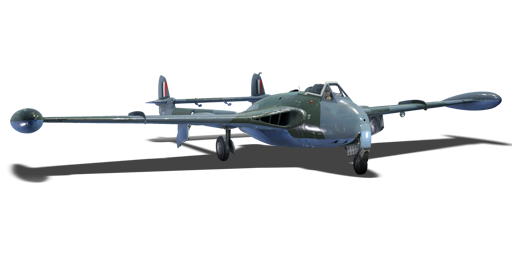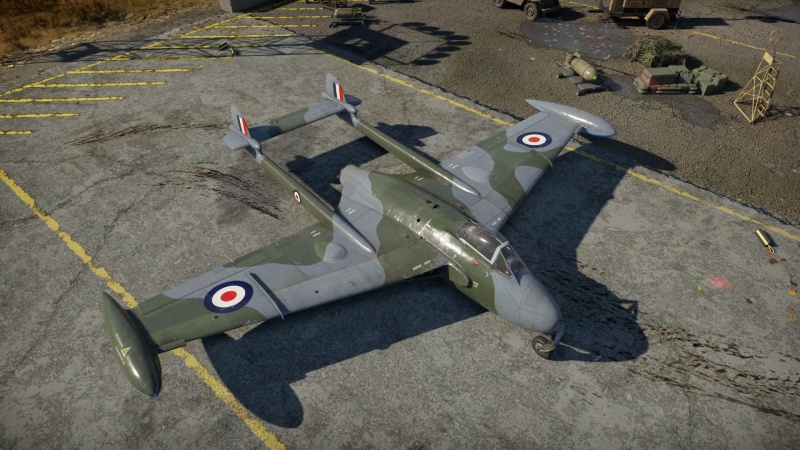Difference between revisions of "Venom FB.4"
Colok76286 (talk | contribs) (→Suspended armament: Edits) |
Colok76286 (talk | contribs) (Edits) |
||
| Line 182: | Line 182: | ||
== Media == | == Media == | ||
| − | ''Excellent additions to the article would be video guides, screenshots from the game, and photos.'' | + | <!-- ''Excellent additions to the article would be video guides, screenshots from the game, and photos.'' --> |
| + | |||
| + | ;Skins | ||
| + | * [https://live.warthunder.com/feed/camouflages/?vehicle=venom_fb4 Skins and camouflages for the {{PAGENAME}} from live.warthunder.com.] | ||
== See also == | == See also == | ||
Revision as of 04:27, 25 March 2022
| This page is about the British jet fighter Venom FB.4. For the naval variant, see Sea Venom FAW 20. |
Contents
Description
The Venom FB.4 is a rank V British jet fighter with a battle rating of 8.7 (AB/RB) and 9.0 (SB). It was introduced in Update 1.43.
Naturally, the Venom follows the basic principles of jet combat. It must keep its speed, turn when necessary, the pilot should avoid speed costly manoeuvres and prefer lag-displacement manoeuvres to any sort of deceleration manoeuvre, unless in critical situations in which the method of energy loss should never be shutting the engine off - instead, utilize the Venom's air brakes.
General info
Flight performance
| Characteristics | Max Speed (km/h at 0 m - sea level) |
Max altitude (metres) |
Turn time (seconds) |
Rate of climb (metres/second) |
Take-off run (metres) | |||
|---|---|---|---|---|---|---|---|---|
| AB | RB | AB | RB | AB | RB | |||
| Stock | 1,013 | 998 | 12192 | 22.2 | 23.5 | 28.2 | 26.0 | 850 |
| Upgraded | 1,038 | 1,027 | 21.8 | 22.0 | 41.1 | 34.2 | ||
Details
| Features | |||||
|---|---|---|---|---|---|
| Combat flaps | Take-off flaps | Landing flaps | Air brakes | Arrestor gear | Drogue chute |
| ✓ | ✓ | ✓ | ✓ | X | X |
| Limits | ||||||
|---|---|---|---|---|---|---|
| Wings (km/h) | Gear (km/h) | Flaps (km/h) | Max Static G | |||
| Combat | Take-off | Landing | + | - | ||
| 0 | 420 | 498 | 469 | 320 | ~10 | ~5 |
| Optimal velocities (km/h) | |||
|---|---|---|---|
| Ailerons | Rudder | Elevators | Radiator |
| < 650 | < 640 | < 640 | N/A |
Engine performance
| Engine | Aircraft mass | ||||||
|---|---|---|---|---|---|---|---|
| Engine name | Number | Basic mass | Wing loading (full fuel) | ||||
| de Havilland Ghost-103 | 1 | 4,157 kg | 230 kg/m2 | ||||
| Engine characteristics | Mass with fuel (no weapons load) | Max Takeoff Weight | |||||
| Weight (each) | Type | 10m fuel | 20m fuel | 30m fuel | 35m fuel | ||
| 1,000 kg | Centrifugal-flow turbojet | 4,700 kg | 5,175 kg | 5,683 kg | 5,966 kg | 7,080 kg | |
| Maximum engine thrust @ 0 m (RB/SB) | Thrust to weight ratio @ 0 m (100%) | ||||||
| Condition | 100% | WEP | 10m fuel | 20m fuel | 30m fuel | 35m fuel | MTOW |
| Stationary | 2,120 kgf | N/A | 0.45 | 0.41 | 0.37 | 0.36 | 0.30 |
| Optimal | 2,120 kgf (0 km/h) |
N/A | 0.45 | 0.41 | 0.37 | 0.36 | 0.30 |
Survivability and armour
- 38 mm Bulletproof glass - Armoured windscreen
- 12.7 mm Steel - Armoured plate behind the pilot
- 3 mm Steel - Armoured plate under the engine
Modifications and economy
Armaments
Offensive armament
The Venom FB.4 is armed with:
- 4 x 20 mm Hispano Mk.V cannons, chin-mounted (150 rpg = 600 total)
Suspended armament
The Venom FB.4 can be outfitted with the following ordnance:
- Without load
- 2 x 1,000 lb H.E. M.C. Mk.13 bombs (2,000 lb total)
- 2 x 500 lb G.P. Mk.IV bombs (1,000 lb total)
- 8 x RP-3 rockets
- 8 x RP-3 rockets + 2 x 500 lb G.P. Mk.IV bombs (1,000 lb total)
Usage in battles
The Venom's play style should be a healthy mix of the two dominating ways of flying jet fighters. The Venom is a fast aircraft, and keeping it fast is important in order to keep up with enemies and to have enough energy to sustain manoeuvres - so the Venom is indeed a good high-speed performer. However, it does not best either the MiG-15bis or the F-86F-2 in level flight. Therefore, speed alone cannot be relied on for fighting jets.
On the other hand, the impressive thrust-to-weight ratio of the Venom's engine means that pilots should use its sustained rate of climb as an advantage. When fighting Soviet opposition - mostly MiG-15s, the advantage in rate of climb falls in relevance, since that is one of the MiG's great trump cards. However, Venom pilots should always climb a bit instead of "mowing the lawn". 600 to 800 km/h is a good range of speed to climb into the battlefield, maintaining airspeed, yet gaining altitude and opening the range of opportunities to engage.
Venom pilots should avoid being alone - in fact, the Venom can excel at baiting enemies and/or making them lose energy, leaving them vulnerable to engagement by allied fighters. The fact that the Venom is not the fastest jet means that being alone vs two or more enemies requires a multitude of defensive manoeuvres (the Venom excels at lag displacement rolls aka. barrel rolls) to come out alive. Sometimes, all it takes is a barrel roll to get behind an enemy and shoot it down, but against multiple opponents that think before manoeuvring, being alone can spell disaster.
Pros and cons
Pros:
- Very manoeuvrable for a jet, comparable to the Meteor Mk 8 with a better roll rate
- Good sustained climb rate, capable of catching up to Me 163s in a sustained climb
- Stable gun platform
- Better cockpit visibility than the Vampire by a bit, depending on your preference it may be the second best to the Hawker Hunter
Cons:
- Inefficient air brakes
- Tail strikes on take-off and landings may be devastating
- Reaches wing-ripping G-forces easily (+12 G)
- Reaches G-LOC easily thanks to manoeuvrability
History
In-game description
The de Havilland DH112 Venom was a single engine jet fighter which entered service with the Royal Air Force in 1952. Initially developed as a private venture with plans for the export market, the Venom was a direct successor to the de Havilland Vampire and shared the earlier fighter's twin tail boom design and composite structure. However, the Venom was fitted with a more powerful de Havilland Ghost jet engine which had begun testing as early as 1944 and had a new, thinner wing. The aircraft was armed with four 20mm Hispano cannon and provisions for up to 2000 lbs of bombs or eight 60 lb rockets.
A prototype first flew on September 2nd 1949 and after a successful period of testing, the first production model Venoms to enter service were the FB1, equipping No.11 Squadron based in Germany in August 1952. A two-seat night fighter variant equipped with radar - the NF2 - entered service with No.23 Squadron at Coltishall in November 1953. After a maiden test flight on 29th December 1953, the Venom FB4 variant entered service with the RAF in 1955. Featuring a modified tailplane, an improved de Havilland Ghost 105 jet engine rated at 5150 lbf and an ejector seat, some 250 were manufactured. This was the final land based version of the aircraft to see service in Britain, although variants of the Sea Venom continued to serve in the Royal Navy's Fleet Air Arm.
RAF Venom FB4s of Nos 6, 8 and 249 Squadrons operating out of Akrotiri in Cyprus flew alongside Royal Navy Sea Venoms in the Suez Crisis of 1956. Venoms were mainly used in the strike role, attacking Egyptian airfields and shipping. Further conflicts where the Venom saw operational use included Malaya, Aden, Oman and Kenya, as well as part of the 2nd Tactical Air Force based in Germany.
Although the Venom's performance built considerably on that of the Vampire it was still, in effect, a first generation jet fighter and was largely outperformed by contemporaries such as the F86 Sabre or MiG 15. The last RAF Venoms were retired in 1962, although export variants were also used by Sweden, Venezuela, Iraq, Australia and Switzerland – the final Swiss Venoms were not retired until 1983.
Media
- Skins
See also
Links to the articles on the War Thunder Wiki that you think will be useful for the reader, for example:
- reference to the series of the aircraft;
- links to approximate analogues of other nations and research trees.
External links
| De Havilland Aircraft Company Limited | |
|---|---|
| Fighters | Hornet Mk.I · Hornet Mk.III · Mosquito FB Mk VI · Mosquito FB Mk XVIII |
| Jet fighters | Vampire F.B.5 · Venom FB.4 · Sea Venom FAW 20 · Sea Vixen F.A.W. Mk.2 |
| Export | ␗Mosquito FB.Mk.26 · ▄Vampire FB 52A(Italy) · ▄Vampire FB 52A(Finland) · A28B |
| Britain jet aircraft | |
|---|---|
| Blackburn | Buccaneer S.1 · Buccaneer S.2 · Buccaneer S.2B |
| British Aerospace | Harrier GR.7 · Sea Harrier FRS.1 (e) · Sea Harrier FRS.1 · Sea Harrier FA 2 |
| British Aircraft Corporation | Strikemaster Mk.88 |
| English Electric | Canberra B Mk 2 · Canberra B (I) Mk 6 · Lightning F.6 · Lightning F.53 |
| Gloster | Meteor F Mk 3 · Sea Meteor F Mk 3 · Meteor F Mk 4 G.41F · Meteor F Mk 4 G.41G · Meteor F Mk.8 G.41K · Meteor F Mk.8 Reaper |
| Javelin F.(A.W.) Mk.9 | |
| de Havilland | Vampire F.B.5 · Venom FB.4 · Sea Venom FAW 20 · Sea Vixen F.A.W. Mk.2 |
| Hawker | Sea Hawk FGA.6 · Hunter F.1 · Hunter F.6 · Hunter FGA.9 · Harrier GR.1 · Harrier GR.3 |
| Panavia | Tornado GR.1 · Tornado F.3 · Tornado F.3 Late |
| SEPECAT | Jaguar GR.1 · Jaguar GR.1A · Jaguar IS |
| Supermarine | Attacker FB 1 · Attacker FB.2 · Scimitar F Mk.1 · Swift F.1 · Swift F.7 |
| Foreign | Phantom FG.1 (USA) · Phantom FGR.2 (USA) · F-4J(UK) Phantom II (USA) |
| Australia | F-111C |
| India | ▄MiG-21 Bison |
| South Africa | ▄JAS39C |





